#Adaptable Site architecture
Explore tagged Tumblr posts
Text

Custom Web Development Services | Ennoble Technologies
Get a user-friendly and responsive website that performs seamlessly across all devices with Ennoble Technologies expert Web Development services.
Do Visit: https://ennobletechnologies.com/web-development/
#web development#Easy to Navigate#Marque Strengthening#Adaptable Site architecture#Visually Alluring Images#SEO Friendly
1 note
·
View note
Text

one of the site image from my camera roll, cant wait to transform it.
#aesthetic#beauty#architecture#design#library#theatre#co working spaces#event area#site visit#adaptive reuse#photography
0 notes
Text
studio styles // part 1



Summary: (Y/N), a newly hired Architectural Assistant at the renowned architecture firm Studio Styles, grapples with imposter syndrome as she navigates the pressures of her first major role in the field. Balancing ambition with uncertainty, she finds herself drawn to her supervisor—Harry, the firm's brilliant yet enigmatic Principal Architect. As professional boundaries blur under late-night deadlines and quiet moments, (Y/N) must confront the question of what she's really building: a career, a future… or something much more complicated.
architect!harry.
Author’s Note: Thank you all for taking the time to read my work! Pleaseeeee let me know your thoughts! Ideas for more are encouraged :)
♡ ♡ ♡ ♡ ♡ ♡ ♡ ♡
The office smelled faintly of concrete dust and expensive coffee—an oddly comforting blend for (Y/N), who still couldn't believe she worked here.
Only one month in, and the sensation of imposter syndrome clung to her like glue. But each time she caught her reflection in the sleek glass doors of the downtown firm, dressed in black slacks and a structured blazer, she reminded herself: You earned this.
Freshly 25, (Y/N) was the firm’s newest Architectural Assistant, freshly graduated with a Master's and still blinking in the unfamiliar rhythm of a life no longer defined by GPA calculators or studio reviews. Her mind often wandered to one question: Who am I now that I’m not a student?
Work, it seemed, was determined to fill that identity vacuum. She welcomed it. Chased it. Whether it was a zoning analysis for a low-rise mixed-use project or drafting elevation concepts for a civic plaza in the City, she raised her hand for everything. Her ambition didn’t just burn—it blazed.
But no amount of ambition had prepared her for Harry Styles.
The moment she had stepped into the interview room a month ago, she had felt it. The unmistakable shift in the air. The strong current between them.
Harry—Principal Architect, her direct supervisor, and the owner of the very firm she now worked at, Studio Styles—was, in a word, unfair. Thirty-seven, tall, and effortlessly magnetic, he carried the kind of refined charisma that seemed to say: Yes, I know I look good in this tailored navy suit, but I promise I won’t make it your problem.
The man who interviewed her, hired her, and now walked past her desk with rolled-up sleeves and the kind of quiet intensity that made architectural specs seem like poetry. Honestly, how was anyone supposed to stay focused?
Everyone in the office respected him, admired him—even joked about him being the "greenest of flags." But (Y/N) saw something else too: a softness in his voice when he explained design theory, the weight he carried in his brow when he thought no one was looking, the restraint in his gaze when their eyes met.
She wondered if he felt it too. That pull.
Harry had kept things strictly professional, of course. She could tell he worked hard to focus only on the technical, the mentorship. But sometimes—when they hovered side by side over CAD drawings or walked together during site visits—she could swear his fingers brushed hers just a moment too long.
Still, she had goals. Real ones. The promotion to Architect I was not guaranteed. It was the next step, the first real test in proving she could belong in this rarefied world. It would be a long year of learning, proving, and adapting.
Romance? That was the plot of her old daydreams, back in undergrad when her biggest worry was a group project going sideways.
Now? Now she had deadlines. Career reviews. A whole identity to build from scratch.
And yet, as she watched Harry gesture thoughtfully at a floorplan from across the room, smiling that small, half-lidded smile that always made her stomach twist—(Y/N) couldn’t help but think:
If I’m building a life from the ground up… is it so wrong that he might be a part of it? Or is this what happens when you spend years chasing degrees and suddenly find yourself in the real world—down bad for your boss like some HR training video gone rogue?
♡ ♡
The hum of the office had quieted, reduced to the occasional tap of a keyboard and the distant whirl of the plotter spitting out floorplans. Most of the team had already cleared out for the evening, but (Y/N) was still at her desk, editing renderings with the intensity of someone who feared the smallest oversight could unravel everything.
She didn’t hear him approach—just the soft sound of leather soles stopping beside her.
"Got a minute?" Harry asked gently, holding a thick project folder in one hand.
She glanced up, blinking. "Yeah, of course."
He gestured toward the small glass-walled conference room at the corner of the floor. Her heart gave the faintest stutter.
What did he want to discuss? Had someone filed a complaint? Was she being fired?
Inside the conference room, he set the folder on the table between them. His sleeves were rolled to the elbows, forearms flexing as he opened the file.
She did her best to hide the nerves tightening her chest, but it was written all over her face.
"Well, don't look so worried," Harry smiled at her reassuringly.
She let out a soft laugh. "I'm sorry, I tend to overthink."
"Don't worry. I actually wanted to discuss a new project with you," he looked at her.
(Y/N)'s brows lifted, curiosity sparking in her expression. A new project? That hadn’t come up in the staff meeting earlier.
"This is the new Rivera Cultural Center downtown," he said, eyes scanning the drawings. "It’s a multi-phase project, community-driven, green-certified. City's backing it heavily, and it's going to be high-profile."
She nodded slowly, her eyes following the path of his finger as it traced the plans. She couldn’t help but notice his hands—steady, capable, and undeniably masculine.
"I want you to take the lead on schematic design," Harry said, looking up at her. "Concept, massing, program alignment, early elevations. You’ll collaborate with me directly."
The words snapped her out of every lingering daydream. (Y/N)'s heart thudded loudly enough; she was sure he could hear it. "Wait—me?"
He smiled faintly. "Yes. You."
She opened her mouth. Closed it again. She wanted to say yes. God, she always wanted to take on a big project. But this one felt… massive.
"I’ve never led something like this before," she said quietly, brows furrowing. "I—I don’t want to mess it up. Or let you down."
"You won’t," he said. "Because I’ll be there. Every step of the way. And I wouldn’t hand you this unless I was sure you were ready for it."
There it was. No patronizing. No sugarcoating. Just belief. Pure and steady.
She lifted her eyes to meet his. And something passed between them then—something unspoken, heavy with possibility. Like the silence before the first line is drawn.
She wondered if he felt it too, that current, that magnetic shift. From the way his gaze held hers, unwavering and sincere, she knew the answer.
But neither of them said it. Not yet.
Instead, she nodded once.
"Okay," she whispered. "I'll do it."
He smiled. And this time, it reached all the way to his eyes.
♡ ♡
The office was quieter than usual this evening, the glow of the city skyline filtering in through the windows as the last of the staff trickled out. (Y/N) had stayed behind, focused on the schematics for the Rivera Cultural Center. She'd already gone over the designs three times, but she couldn't shake the feeling that something was missing.
She was staring at the plans when Harry approached her desk, a soft thud of his shoes on the polished wood floor. She glanced up, startled but grateful for the distraction.
"Everything going okay?" Harry asked, his voice warm but low.
She smiled, pushing the frustration aside. "Yeah. Just trying to figure out the massing for the main lobby. I feel like I’m overthinking it."
"You are," he teased lightly, sitting down in the chair across from her. But his eyes softened as he continued, "But that’s good. Means you're invested."
She shifted in her seat, pulling up a few of the elevation designs. "I just don’t want to miss anything. I want it to be perfect."
"You’re on the right track," Harry said, leaning forward slightly, his gaze locked on the plans. He was close enough now that she could see the faint creases in his shirt, the way the lines of his suit jacket stretched over his shoulders. His presence was comforting, grounding her. "We’re getting there. I can help you with this—walk you through the next step."
She hesitated, glancing up at him, meeting his eyes. He seemed genuinely invested in her progress. There was no condescension, no rush. Just the quiet assurance that she was more than capable.
"You’ve been really supportive," she admitted, almost shyly. "I didn’t expect it to be like this. I thought you'd… I don’t know, be more hands-off."
"Do you want me to be hands-off?" he quickly asked.
She looked up, their eyes immediately connecting.
There was a slight pause. "N-No," she stuttered.
A faint smile tugged at his lips as his gaze lingered on her face. They both turned their attention back to the plans, but there was something different in the air now, something thicker between them that made the space feel smaller, more intimate.
Harry stood, moving to the whiteboard beside her desk to sketch a few notes. She could feel the subtle shift in energy as he reached over her, their shoulders brushing for just a second. It wasn't intentional, but the warmth of his body, the nearness, sent a jolt through her.
When he stepped back, their eyes met again. She was sure he felt it too—the quiet tension hanging in the air, the pull that neither of them acknowledged aloud.
"It's getting late… you should probably head out," (Y/N) said, glancing toward the window where the sky had already begun to fade into evening hues.
"Yeah, I'll get going soon. Just want to make sure you're alright," he said.
The sincerity in his voice truly touched (Y/N).
"I don't know what I'd do without you on this," she admitted.
He stepped closer, gaze on her.
Harry’s expression darkened. His hand came up, brushing a stray strand of hair behind her ear. His fingers lingered.
"You won't ever have to find out," he murmured.
That did it.
Her breath hitched just before he leaned in, and then his mouth was on hers—firm, searching, not hesitant at all. She responded instantly, her hand sliding into his shirt collar, pulling him closer. The kiss deepened, the weight of everything they hadn't said crashing into that one desperate moment.
His hand found her waist, and with a quiet groan he walked her back until she bumped into the edge of the desk. The plans crinkled beneath her as he lifted her—strong hands guiding her to lie back over the very designs they’d been pouring over just minutes earlier.
The moment was charged, a collision of ambition, desire, and months of restraint finally breaking loose.
He hovered over her, breathing hard. "Tell me to stop."
She didn't.
Instead, she reached up and kissed him again.
The kiss was breathless and all-consuming. Harry's hands framed her hips, her fingers curled into his shirt. Every thought, every rule, every hesitation had vanished the second their lips met. The sound of paper rustling beneath them—plans and sketches now forgotten—only fueled the urgency.
And then—ding!
The elevator doors slid open with a mechanical chime, slicing through the moment like a blade.
They froze.
A beat later, the telltale squeak of rubber wheels echoed down the hall, followed by the soft clatter of cleaning supplies and the faint shuffle of footsteps. The janitor had arrived for the night shift.
Harry pulled back, breathing heavily. (Y/N) sat up fast, heart hammering, cheeks flushed as she frantically smoothed down her blouse and skirt. He ran a hand through his hair, adjusting the collar of his shirt, then leaned casually against the edge of the desk like they'd been talking about floor plans—not making out on top of them.
A faint tune drifted into the studio—some upbeat song the janitor was whistling along to, completely oblivious, earbuds tucked firmly into his ears. He didn't even glance their way as he pushed the trash bin through the hallway, humming to himself and wheeling toward the break room.
(Y/N) let out a breath she hadn’t realized she was holding.
"That was close," she whispered, glancing sideways at Harry.
He looked at her, and despite the attempt at nonchalance, there was a spark in his eyes—mischief, disbelief, desire. His lips curved into a crooked smile, a silent what just happened? passing between them.
She couldn't help the grin that tugged at her own mouth, biting the inside of her cheek to suppress it. Their gazes lingered, playful and loaded.
Neither of them said a word, but the silence said everything.
This wasn’t over.
Not by a long shot.
♡ ♡ ♡ ♡ ♡ ♡ ♡ ♡
Author's Note: Thank you all for taking the time to read my work! How are we liking architect!harry?
#harry edward styles#harry x y/n#harry styles fluff#harry styles smut#harry styles angst#harry styles x reader#harry styles blurb#harry styles one shot#harry styles fanfiction#harry styles#harry styles au#harry styles slow burn#slow burn
163 notes
·
View notes
Text
"Traditional European ArchitectureTM is the best! modern architecture is degenerate!"
"alright, well, putting aside my strong disagreement on the philosophical/ethical undertones of your statement- I do love old buildings! you must be a big proponent of paid apprenticeships for preservation students"
"um what?"
"well, people have to know how to preserve these buildings. and as it stands now, only those willing to go into student debt or with family money to fall back on while they study can afford to learn the techniques involved (unless they're lucky enough to be born into a family with their own preservation contracting business). young people aren't going into these fields even if they want to, because they can't take the financial hit"
"yes but why should anyone have to pay them to learn? they should pull themselves up by their bootstraps!"
"...right. well, what about preservation grants? nationalizing historical site museums?"
"government handouts! no way!"
"preserving and revitalizing traditional forms of building craftsmanship, like decorative masonry or plasterwork, stained glass, tiling, clockmaking, etc?"
"those things cost too much and will hurt the building company's bottom line!"
"talking about the people whose labor made these incredible works of architectural art possible?"
"woke history!"
"adaptive reuse, like letting businesses rent historical buildings with appropriate restrictions on modification?"
"ew! not in my backyard!"
"traditional buildings in styles from other parts of the world?"
"no, no, no! everyone knows western art is the most ~highly evolved~!"
"so, let me get this straight: you just want grand old buildings to be there, and stay perfectly intact, unused for anything, with no effort whatsoever. and you want new buildings to happen in that style but somehow as cheaply as throwing up a glass-and-steel skyscraper that starts falling apart in six months? also only western-style buildings, and we should only talk about very specific people who occupied them?"
"yes!"
"my guy, you don't actually love old architecture"
#architecture#old buildings#if contractors were willing to pay more for decent and decorated construction#or billionaires valued young people learning these skills so they don't die out#we might have modern buildings in that style- in ANY traditional style the world over -and we'd be able to save more of them#they also don't want to talk about how builders and other architectural craftspeople have a history of strong collective action#going back to medieval guilds#(also of course all of this is thinly-veiled racism)#(they don't really care about the architecture)
185 notes
·
View notes
Text
Humans are so cute. They think they can outsmart birds. They place nasty metal spikes on rooftops and ledges to prevent birds from nesting there.
It’s a classic human trick known in urban design as “evil architecture”: designing a place in a way that’s meant to deter others. Think of the city benches you see segmented by bars to stop homeless people sleeping there.
But birds are genius rebels. Not only are they undeterred by evil architecture, they actually use it to their advantage, according to a new Dutch study published in the journal Deinsea.
Crows and magpies, it turns out, are learning to rip strips of anti-bird spikes off of buildings and use them to build their nests. It’s an incredible addition to the growing body of evidence about the intelligence of birds, so wrongly maligned as stupid that “bird-brained” is still commonly used as an insult...
Magpies also use anti-bird spikes for their nests. In 2021, a hospital patient in Antwerp, Belgium, looked out the window and noticed a huge magpie’s nest in a tree in the courtyard. Biologist Auke-Florian Hiemstra of Leiden-based Naturalis Biodiversity Center, one of the study’s authors, went to collect the nest and found that it was made out of 50 meters of anti-bird strips, containing no fewer than 1,500 metal spikes.
Hiemstra describes the magpie nest as “an impregnable fortress.”
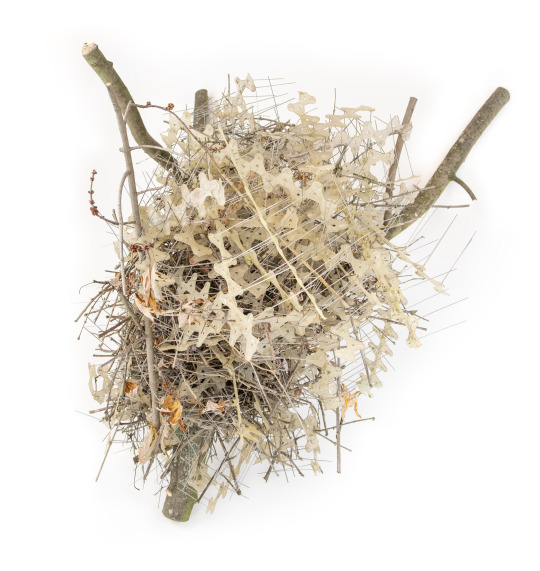
Pictured: A huge magpie nest made out of 1,500 metal spikes.
Magpies are known to build roofs over their nests to prevent other birds from stealing their eggs and young. Usually, they scrounge around in nature for thorny plants or spiky branches to form the roof. But city birds don’t need to search for the perfect branch — they can just use the anti-bird spikes that humans have so kindly put at their disposal.
“The magpies appear to be using the pins exactly the same way we do: to keep other birds away from their nest,” Hiemstra said.
Another urban magpie nest, this one from Scotland, really shows off the roof-building tactic:
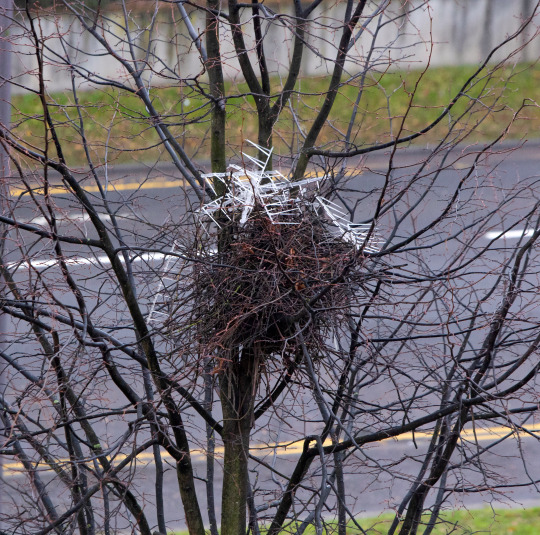
Pictured: A nest from Scotland shows how urban magpies are using anti-bird spikes to construct a roof meant to protect their young and eggs from predators.
Birds had already been spotted using upward-pointing anti-bird spikes as foundations for nests. In 2016, the so-called Parkdale Pigeon became Twitter-famous for refusing to give up when humans removed her first nest and installed spikes on her chosen nesting site, the top of an LCD monitor on a subway platform in Melbourne. The avian architect rebelled and built an even better home there, using the spikes as a foundation to hold her nest more securely in place.
...Hiemstra’s study is the first to show that birds, adapting to city life, are learning to seek out and use our anti-bird spikes as their nesting material. Pretty badass, right?
The genius of birds — and other animals we underestimate
It’s a well-established fact that many bird species are highly intelligent. Members of the corvid family, which includes crows and magpies, are especially renowned for their smarts. Crows can solve complex puzzles, while magpies can pass the “mirror test” — the classic test that scientists use to determine if a species is self-aware.
Studies show that some birds have evolved cognitive skills similar to our own: They have amazing memories, remembering for months the thousands of different hiding places where they’ve stashed seeds, and they use their own experiences to predict the behavior of other birds, suggesting they’ve got some theory of mind.
And, as author Jennifer Ackerman details in The Genius of Birds, birds are brilliant at using tools. Black palm cockatoos use twigs as drumsticks, tapping out a beat on a tree trunk to get a female’s attention. Jays use sticks as spears to attack other birds...
Birds have also been known to use human tools to their advantage. When carrion crows want to crack a walnut, for example, they position the nut on a busy road, wait for a passing car to crush the shell, then swoop down to collect the nut and eat it. This behavior has been recorded several times in Japanese crows.
But what’s unique about Hiemstra’s study is that it shows birds using human tools, specifically designed to thwart birds’ plans, in order to thwart our plans instead. We humans try to keep birds away with spikes, and the birds — ingenious rebels that they are — retort: Thanks, humans!
-via Vox, July 26, 2023
#birds are literally learning how to better live/survive alongside us#this is like. actually kind of remarkable. and the technique is spreading including to other species.#is this hopepunk? it kinda feels like hopepunk to me.#animals are literally learning how to use our attempts to get rid of them against us#that's kind of amazing#and also VERY encouraging re: life's innate resilience#crows#magpie#corvid#crow#bird#bird nest#bird nerd#bird news#adaptation#urban animals#ornithology#climate adaptation#kinda#good news#hope#hope posting#hopepunk#animal intelligence#wildlife#animals are awesome
1K notes
·
View notes
Text

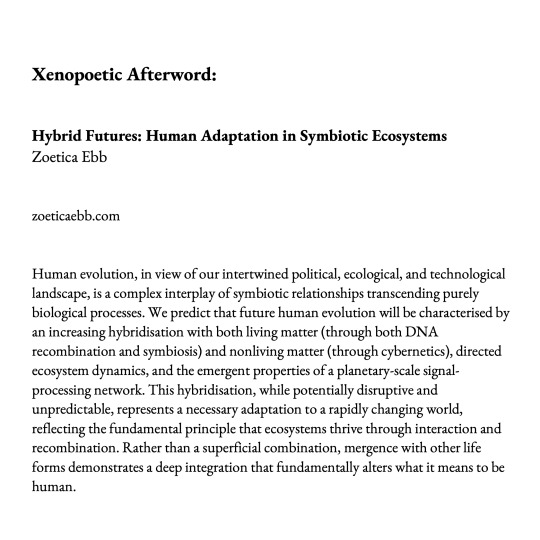

My contributor’s copy of Xenobacillus glossophagii. It's an incursion into the microbial mechanics of language, trauma, and subjectivity by Kenji Siratori. In this treatise, Siratori [@xenopoem] conjures a parasite that infiltrates the architecture of language itself, rewriting syntax, meaning, and subjectivity in recursive waves of glossophagic spirals and semiotic collapse. Splicing glitch aesthetics, bacteriological theory, and philosophical speculation, Siratori spins a machinic delirium where words are wounds and language becomes a site of infection. For readers of Artaud, Serres, Haraway, and Wittgenstein, Xenobacillus glossophagii is biolinguistic horror at its most intimate and systemic.
Closing the volume is my xenopoetic afterword, Hybrid Futures: Human Adaptation in Symbiotic Ecosystems, which reframes contagion within an ecological and technobiotic paradigm. I propose a planetary-scale hybridization where humans co-evolve with both living and nonliving systems. Through the lens of "least-interaction boundaries" and other conceptual frameworks from my Alien Botany system, I envision a post-anthropocentric biopolitics, one where species merge not through conquest but through semiotic resonance and emergent complexity.
Cover art: Lenticus Somnium Remix by me. Inside: a path to a soundtrack merging my voice with Siratori’s noise.
Xenobacillus glossophagii is a mutagenic manifesto for the end of stable identities and a vector for cognitive recombination.
Buy it. Read it.
#zoetica ebb#kenji siratori#Xenobacillus glossophagii#xenopoem#literature#text#writing#my work#avant garde#hybridization#parasitism#symbiosis#horror#language horror#alien botany
59 notes
·
View notes
Photo

Britomartis
Britomartis, also known as Diktynna (Dictynna), was the Cretan goddess of hunting and fishing nets in Greek mythology. Although referred to as a nymph and worshipped locally, she had at least two significant and active shrines, one in Crete and another in Aigina, where worshippers would bring offerings. They regarded her as a vanished maiden immortalized and deified by Artemis.
According to her most popular myth, Britomartis, meaning "sweet maiden," was an exceptional huntress and a beloved companion of Artemis. As such, she had vowed to remain a virgin. Nevertheless, King Minos desired her and relentlessly pursued her for nine months. He eventually caught her atop a high peak and attempted to seize her, but Britomartis leaped from the cliff into the sea to escape. She was recovered by fishermen's nets (diktuon) and brought to the island of Aigina. There, Artemis transformed her into the goddess of the nets, Diktynna, to preside over her own cult.
Despite her clear Cretan origins, Britomartis/Diktynna was likely a minor goddess who was reintroduced into the Bronze Age pantheon of the island by Classical Greek writers. Over time, Diktynna came to be associated with divine genealogies and was even included among the children of Leda by Zeus, Apollo and Artemis. Her cult remained popular throughout the Hellenistic and Roman Imperial periods, as evidenced by the archaeological remains of her sanctuaries and the coins bearing her image.
In Minoan Religion
The Cretan system of sacred beliefs and practices is marked by impressive processions, bountiful sacrifices and offerings, mystery symbols such as the double-axe (labrys), and ritual activities such as bull-leaping. It also features painted and sculpted images of female characters commonly interpreted as goddesses or priestesses, most typically with raised arms. Some of these goddesses/priestesses are shown holding snakes, which led Sir Arthur Evans (1851-1941), the key figure in the discovery of the Minoan civilization, to suggest they may represent a 'Great Mother Goddess' and her fellow associates.
The discovery of numerous inscriptions at Knossos, an archaeological site he believed to be King Minos' palace, convinced Evans that deciphering these inscriptions would reveal a clear understanding of his material finds and their significance in the Minoan religion and culture. He dedicated his life to this effort, only to find that the inscriptions represented three different scripts: Cretan Hieroglyphs, Linear A, and Linear B. While the first two scripts remain undecoded, the Linear B script was eventually deciphered by Michael Ventris (1922-1956). As nearly all the tablets read since then contain administrative and commercial records, understanding the Minoan religion has largely remained dependent on drawing parallels between pieces of visual evidence from art, archaeology, and architecture. In other words, we have no written evidence yet that can directly tell us what the Minoans used to call their goddess or goddesses.
Minoan Snake Goddess, Knossos.
Mark Cartwright (CC BY-NC-SA)
Still, there is a foundational agreement among the scholars that the Minoan religion, like many other aspects of this culture, was later adopted or adapted by the Mycenaeans and Greeks. Just as Michael Ventris demonstrated that the language of Linear B inscriptions is an early form of Classical Greek, scholars such as Jennifer Larson explain that
From its beginnings in the Bronze Age, “Greek” religion was a synthesis. The strong influence of Minoan ideas and aesthetics is clearly discernible in the material culture of Mycenaean religion…
(138)
The idea of the persisting prominence of several gods and goddesses such as Zeus, Apollo, Dionysus, and Athena from the Minoan down to the Mycenaean and Greco-Roman cultures finds material support in the names of these deities on a few Linear B tablets. These tablets were discovered at the Palace of Nestor in the Mycenaean city of Pylos, c. 1200 BCE. The tablets list the offerings and sacrifices that were dedicated, or must be dedicated, to each deity. On one tablet, Tn 316, the divine recipients of gold vessels include Zeus, Hermes, Hera, and Potnia. The name Potnia, written as po-ti-ni-ja in Linear B, means "The Female God Who Has Power." This title was given to several important goddesses in Minoan Crete, sometimes as an epithet, e.g. Potnia Athena, sometimes denoting the geographical or functional attribute of the goddess, e.g. Potnia Hippia (Mistress of the Horses), and sometimes solely as her name or title. If we trust that Potnia must be the Minoan/Mycenaean designation for sacred female figures in the Minoan art because they are both noticeably frequent, then it is likely that this Minoan/Mycenaean great goddess survived the Bronze Age Collapse and made her way into the Archaic Greek pantheon in the form of one or more female deities.
Since the Bronze Age goddess was often featured concerning warfare and protection, most scholars suggest that Athena is the Greek revival of Potnia. Nevertheless, the Cretan goddess, who was consistently honoured and praised by Greek writers from the 5th century BCE onwards, was Britomartis/Diktynna. And she was explicitly linked to Artemis and, later, to her divine family.
Minoan Gold Signet Ring with Three Figures before a Temple
Nathalie Choubineh (CC BY-NC-SA)
Continue reading...
38 notes
·
View notes
Text
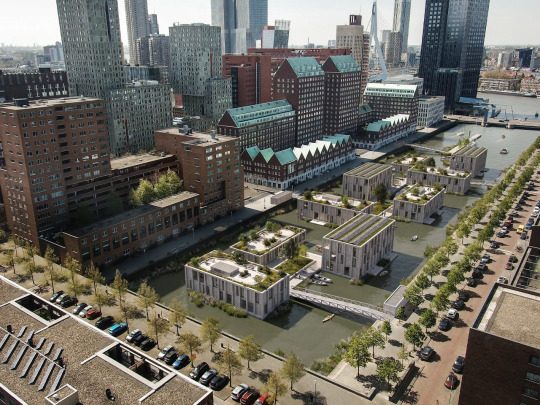
Rotterdam's Solarpunk Aesthetic manifests in floating new neighbourhood
The Spoorweghaven community, designed by Danish maritime architects MAST, presents a vivid vision for the future. With over a hundred low-cost apartments, commercial spaces, and a recreational harbor, this floating development is more than an engineering feat—it is a celebration of Scandinavian ingenuity and urban adaptability.

In a country where water and land have always danced a delicate waltz, this project proposes a new choreography—one where homes, public spaces, and even gardens gently float above the ground. The design respects the Dutch tradition of living with water, yet speaks with a distinctly Nordic sensibility, favoring clean lines, communal zones, and a seamless connection to nature.
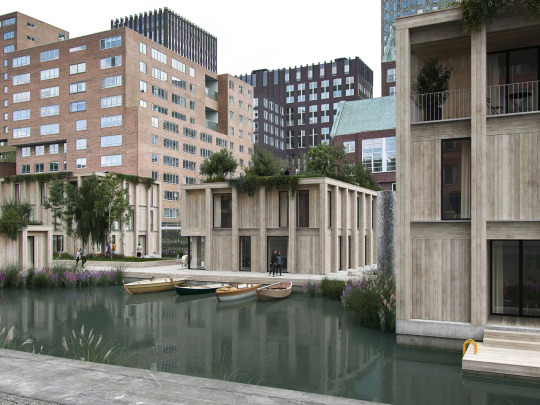
MAST collaborated with the Scottish company Biomatrix to create over 900 square meters of floating reed beds that encircle the perimeter of the site. These reeds do more than beautify the edge—they cleanse the harbor water, attract birds and fish, and bring a soft, living border to the modular forms. The buildings themselves are constructed off-site and then towed into position, a method that minimizes disturbance and celebrates the logic of Scandinavian prefab traditions.
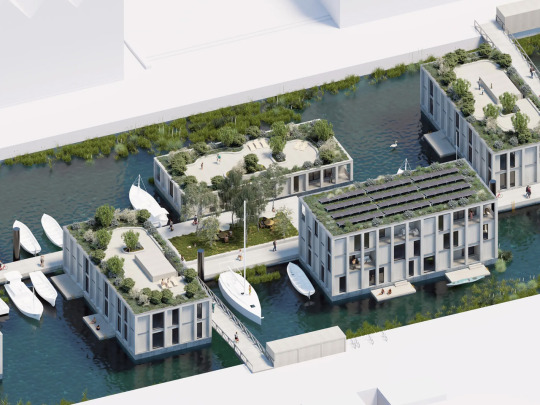
The sense of community is gently woven into every aspect of the development. Shared green spaces and walkways become informal meeting points, while the continuous blue ribbon of navigable water invites both residents and visitors to experience the city from an entirely new vantage. The architecture does not impose, but rather settles in lightly and thoughtfully, making space for both human and non-human life.
17 notes
·
View notes
Text
"I've seen suffering in the darkness. Yet I have seen beauty thrive in the most fragile of places." - History, Culture and Identity in Cartoon Saloon's Irish Mythology Trilogy
Written accounts of Irish history and culture only begin to appear from the 5th century onwards and what came before we are left to piece together from archaeological remains whose meanings and motivations we can only guess at. What is clear, though, is that during that broad stretch of time between the Early Mesolithic and Late Iron Age, a distinctly Irish identity had been established and developed on by the craftsmen, artists, hunters, foragers, farmers and warriors that populated the country, through their housing, weaponry, metalworks and stone monuments. The development of the Christian church throughout the Early Medieval period brought its own beauty to the art and architecture of the country, but also adapted its culture to suit the needs of an integrating religion and sites and ceremonies of pagan worship were amalgamated into the Christian calendar. Following this were Viking raids, Anglo-Norman settlement, English conquest, plantation, oppression, rebellion, famine and civil war. From the Early Medieval period to the present day Ireland has experienced an almost constant shift in leadership and identity with little time in between for the dust to settle. Culturally, a "Celtic Revival" in the late 19th and early 20th centuries sought to re-invigorate the arts and history of Celtic Ireland (a broad, problematic concept in itself) as an expression of nationalism and to bolster a distinctly Irish artistic and literary identity.
All of this is to say that wading through Ireland's history of social upheaval, religious and political conflict, and loss and confusion of identity is no mean feat. To take those threads and conjure up original stories for modern audiences, embracing the suffering and celebrating the beauty, is impressive. To do it three times is witchcraft.
In their films depicting Irish history, culture and mythology, animation studio Cartoon Saloon have approached their stories with a respect for the past, both fact and fiction. By evoking the artwork, legends and real history of Ireland's past and combining it with their own fresh, unique visual style, Cartoon Saloon brings some much needed authenticity and vibrancy to the depiction of Ireland in mainstream culture. Absent are the twee figures of backwards island folk or the commercialised idolatry of a St. Patrick's Day parade. What we get instead is something more personal, recognisable on the surface to every child and adult who learned about Fionn, the Fianna and fairy circles in primary school and with nuggets of information and visual cues for explorers of Ireland's broader history.
"I can't tell you which parts of this story are true and which parts are shrouded by the mists." - The Secret of Kells and the line between history and mythology
Set roughly in the 9th century AD The Secret of Kells is the earliest depiction of Irish culture in the trilogy, a period which saw the continued integration of Christianity into the country alongside traditional pagan practices and festivals, a relatively soft conversion compared to later events. Although the main character, Brendan, comes from a Christian monastery and carries those beliefs, The Secret of Kells does well to capture this balance between a new religion and old beliefs with the inclusion of Aisling and Crom Cruach, who live alongside the monastery and influence the story as much as Brendan and the brothers do and whenever Brendan is punished by Abbot Ceallach it is for disobedience not a lack of faith.
"It is with the strength of our walls that they will come to trust the strength of our faith." Abbot Ceallach's fierce desire to build a wall around the monastery is fueled mostly by the threat of Viking raids, but it is his hope as well that the protection they offer will encourage the faith of the natives and draw them behind those walls. Abbot Ceallach finds comfort and safety in his monastery and danger and violence outside of its walls, so, not only does the wall protect them from invaders but it also cuts them off from the forest beyond - the domain of shape-shifters, wild animals and pagan temples, a world which Brendan can only glimpse through a crack in the wall. A staple of the entire trilogy is this depiction of wilderness in some form and its association with Ireland's symbolic wilderness and pagan ancestry. What sets it apart from the threat of Vikings is that, in spite of its wildness, it poses no threat to their way of life. When Brendan enters the forest for the first time it is dark and frightening until Aisling, an ethereal Sídhe figure who can shape-shift into a wolf, shows him how to navigate it and suddenly the forest grows bright and beautfiul, Brendan's fear is eliminated and Aisling becomes his friend.
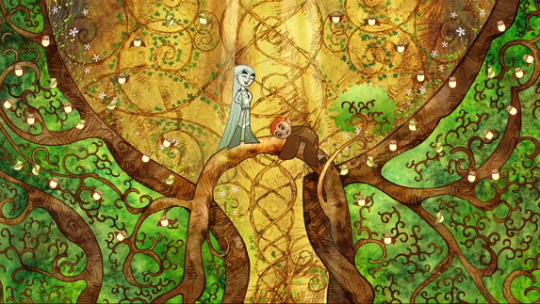
Hidden throughout Brendan's trek in the forest are old, moss covered ogham stones and stone circles, allusions to native practices, but deeper in, the colour palette changes from bright greens and natural browns to a wash of dark greys and black when Brendan stumbles across a temple to Crom Cruach (a deity who, in Irish mythology, is eventually destroyed by St. Patrick). Aisling tries to warn him away, "It is the cave of the Dark One," but Brendan dismisses her worries, "The abbot says that's all pagan nonsense, there's no such thing as Crom Cruach." At the sounding of the deity's name, black tendrils emit from the cave and pull on Aisling as she stops them reaching Brendan. Later, Brendan returns to the cave to steal Crom's eye - a magnifying crystal that will help Brendan and Brother Aidan with their illumination. In a beautifully animated sequence Brendan battles Crom Cruach in his cave by trapping him in a chalk circle and stealing his eye. Crom Cruach is depicted as a never-ending snake (in a geometric pattern similar to both pre-Christian art and the knotwork of Christian manuscripts) possibly in reference to the 'snakes' banished from Ireland by St. Patrick. What's most fascinating about this sequence is that Brendan experiences it at all. Although the experience is supernatural it is never implied as anything other than real. Brendan is a committed monk in training who will spend his life in service to the monastery; even after meeting Aisling and battling Crom Cruach he never questions his faith or his elders and when he returns to the monastery with the eye no one disputes the story of how he came by it, "You entered one of the Dark One's caves?" At this time, at the edge of a growing monastery and with a direct reference to the abbot's desire to convert the natives, there is still space for pagan ideas to exist. Similarly, Aisling using Pangur Bán's spirit to free Brendan has an effect on the real world. There's an argument to be made that this is a film and anything can happen, but for problems to be solved by magic, the way Aisling frees Brendan, firm world-building rules must be established and in this world, 9th century Ireland, spaces exist in which otherworldly figures reside and actions beyond the mortal realm occur, and these spaces exist alongside the film's version of civilisation.
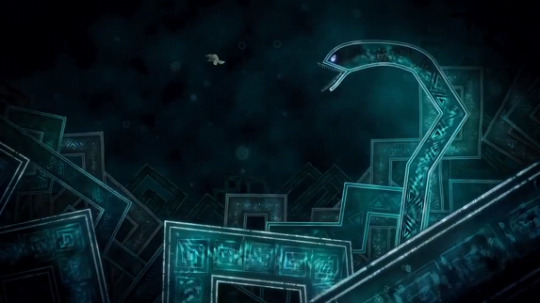
"I have lived through all the ages, through the eyes of salmon, deer and wolf." As an animated feature, there is a lot the film can tell us through visuals alone, and The Secret of Kells does a wonderful job capturing an Ireland in transition. The prologue opens with a close-up image of the Eye of Crom with abstract shapes swimming around it, followed by a glimpse of Aisling hiding in a tree as she narrates over these images in an eery whisper. Following these we see a salmon, deer and wolf, three animals important to Irish mythology, identity and history; the salmon, related to The Salmon of Knowledge, represents mythology, the deer is the national animal of Ireland, and wolves (in the world of Cartoon Saloon) represent its wildernes and history (the elimination of the wolf population became more active in Ireland during times of English occupancy, a theme that is explored more deeply in Wolfwalkers). Even the waves crashing around Iona as Brother Aidan escapes morph into wolves, futhering their symbolism as something wild and dangerous, but natural and not actively destructive like the Viking raiders. The monastery is littered with Iron Age motifs existing alongside Early Christian imagery. Spiral motifs occur in trees and plants, in the ropes that bind the wall's scaffolding together, and circular, semi-circular and zig-zag shapes continue to appear with knot-work patterns and religious figures - even the snowflakes falling during the raid are strands of knot-work. The monastery itself is accurate to the period with its round tower, beehive shaped structures (called clochán) and the town growing around it, while outside its walls Brendan crosses a stone circle. We even see a game of hurling, the ultimate unifying bridge between pagan and modern Ireland. The walls of the abbot's cell are covered in his own drawings of plans for the monastery's construction. These are exquisitely detailed and clearly a plan for the future but drawn in a style that cannot escape the past. Zig-zags, spirals, circles, semi-circles, dots, triangles, sun and star motifs and something that looks like an alignment chart - the style is evocative of Neolithic and Bronze Age art and the insular La Tène style that preceded the arrival of the monks in Ireland, all styles that combined the abstract and geometric, seemingly random, but clearly symbolising something greater.
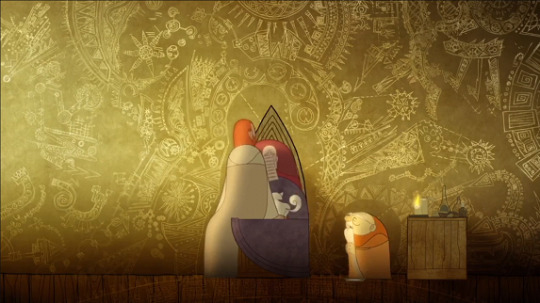
"You must bring the book to the people." In their last interaction as children Aisling helps Brendan recover the pages of his manuscript as he flees the Vikings. In this gesture Aisling aids Brendan on his religious journey - during the montage later on she even guides him home. Faith never comes between these two - it doesn't need to since Aisling's existence and her convictions are as real and strong as Brendan's. Their relationship is one of mutual curiosity and sharing their differences. In Irish mythology, female figures (particularly shape-shifting ones) are often symbolic of Ireland itself and to have the support of these figures is, for kings and heroes, a mark of validation. At this time, these two worlds still live alongside each other and Aisling is allowed to support Brendan's work as a monk while maintaining her own natural way of life, while Brendan can learn about pagan concepts from Aisling without wavering from his faith or trying to mould her to his. Although Brendan's final journey home shows the spread of Christianity across the country we get one final image of Aisling, changed to her human form in a flash of lightning, that shows us while she might be hiding she hasn't disappeared just yet, while Brendan, now an adult, returns to Kells, committed to continuing Abbot Ceallach's work.
"This wild land must be civilised" - Wolfwalkers and the taming of Ireland
Set in 1650, Wolfwalkers occurs roughly 800 years after The Secret of Kells and presents a vastly different universe. The monks' Christianisation of the natives was a far more gentle affair and one founded in a desire to educate and adapt. Ireland under the Lord Ruler (a stand-in for Oliver Cromwell) is a world of service, punishment and fear. By chopping down trees and employing hunters to cull the wolf population the Lord Ruler is attempting to tame the countryside and, most importantly, the people themselves. References to "the old king" and "revolt in the south" place us, historically and politically, in the Cromwellian Conquest, when Cromwell was sent to Ireland to quell uprisings against the newly established English Commonwealth. Heavy stuff and this is a simplification of a period of major conflict in Ireland but Wolfwalkers successfully impresses on us the feeling of living under the thumb of an active oppressor on a personal scale. The Lord Ruler wants the people of Kilkenny afraid and complacent so that they support his efforts to cull the wolves and cut down their forests. Unlike Abbot Ceallach who fears a real threat in the Vikings, the Lord Ruler fabricates a threat in the wilderness beyond the city walls in order to bend people to his will, "Oh, lass. Lord Protector has strict rules." Although the wolves pose no threat to the city, people have been made to fear them, resulting in the loss of their connection to the forest outside the town walls. One character even says that the wolves are attacking them because they've been chopping trees down, because they've been going against their ancient pacts: "
Set in 1650, Wolfwalkers occurs roughly 800 years after The Secret of Kells and presents a vastly different universe. The monks' Christianisation of the natives was a far more gentle affair and one founded in a desire to educate and adapt. Ireland under the Lord Ruler (a stand-in for Oliver Cromwell) is a world of service, punishment and fear. By chopping down trees and employing hunters to cull the wolf population the Lord Ruler is attempting to tame the countryside and, most importantly, the people themselves. References to "the old king" and "revolt in the south" place us, historically and politically, in the Cromwellian Conquest, when Cromwell was sent to Ireland to quell uprisings against the newly established English Commonwealth. Heavy stuff and this is a simplification of a period of major conflict in Ireland but Wolfwalkers successfully impresses on us the feeling of living under the thumb of an active oppressor on a personal scale. The Lord Ruler wants the people of Kilkenny afraid and complacent so that they support his efforts to cull the wolves and cut down their forests. Unlike Abbot Ceallach who fears a real threat in the Vikings, the Lord Ruler fabricates a threat in the wilderness beyond the city walls in order to bend people to his will, "Oh, lass. Lord Protector has strict rules." Although the wolves pose no threat to the city, people have been made to fear them, resulting in the loss of their connection to the forest outside the town walls. One character even says that the wolves are attacking them because they've been chopping trees down, because they've been going against their ancient pacts: "Everyone knows you can't be cutting down their woods. If you do, they'll get you. Sure, that's the deal...Saint Patrick made it with the old pagans and you're breaking it, you eejits!" Of course, any reference to a world ouside of the current mode of conduct is cause for immediate punishment and suppression and the wood cutter is quickly quieted. Even Bill and Robyn, loyal English citizens, are punished. Robyn is forced to work as a maid in the castle when she begins to speak of wolves and Wolfwalkers and when Bill fails to cull the wolf population (and control his own daughter) he is stripped of his rank as hunter and forced into the role of soldier, robbed of the little freedom he had.
"This once wild creature is now tamed, obedient, a mere faithful servant." Although this line is spoken in reference to Moll, held captive in a cage in her wolf form, it is the human characters who suffer the most from this ideology - even the nameless background characters are confined to the walls of the city in fear of punishment, "Lord Protector put my father in chains for nothing." What comes to mind when hearing of tamed creatures is not Moll in her cage, who exudes strength and power even behind bars, but Robyn in her maid's uniform, once lively and imaginative, now returning home with lines under her eyes after a long day of hard, monotonous work, and Bill, quieting his daughter's eagerness in fear for what will happen to her, then later shackled at the neck and forced to march behind the Lord Ruler's horse when he disobeys, "We must do what the Lord Ruler commands". Although Moll is held captive too, it is in the form of a humongous wolf; she is locked away in the Long Hall for fear of the danger she represents. The Lord Ruler is aware of how poweful she is and so he must keep her locked up to show the people of Kilkenny just how much control he can wield, quelling any potential notions of power they might have held in themselves. And in the case of Moll, Robyn and Bill, each time they are held captive by the Lord Ruler, their captured bodies submit to the wolf form to escape, drawing on a deep-rooted strength and wildness within themselves to escape the confines of the Lord Ruler's rigid society.
"What cannot be tamed, must be destroyed." The ending of Wolfwalkers is bittersweet; Robyn, Médb and their parents are safe after defeating the Lord Ruler and his soldiers, but they are still forced to leave their forest home. "All is well," Bill and Robyn tell each other, and the family appear content, but, before now, leaving the forest was not on the agenda; leaving the forest meant retreating from a threat and this is still the case. Médb wanted to save the forest, but, after everything that's happened, the family are no longer safe on the borders of the town. Robyn, Médb, Bill and Moll might have saved each other but they can't save their home and the people still living behind the city walls - the Lord Ruler may have been killed but that doesn't mean the end of his conquest. Historically, this period saw Ireland amalgamated into the Commonwealth and Irish Catholic landowners ousted by English colonists, the diminishing of Irish customs and traditions, and a high level of deforestation and the elimination of the wolf population. The family's departure from Kilkenny allows viewers a safe, happy, narratively satisfying ending, without erasing the changing social tides that occurred at the time or ignoring the history that followed.

"Remember me in your stories and in your songs" - Song of the Sea and loss:
If Wolfwalkers is the taming of Ireland then Song of the Sea is Ireland tamed. Set roughly in the 1980s it is the closest depiction of a modern Ireland in Cartoon Saloon's ouevre. In contrast to The Secret of Kells and Wolfwalkers, which represented Ireland's native identity in the forest, here it takes the form of (drumroll) the sea, but while those other films depicted the battle between the wilderness and civilisation Song of the Sea depicts its defeat. The last of the Sídhe live in hiding in a rath disguised as the centre of a roundabout and use a sewage system to get around. In their diminshed forms, Lug, Mossy and Spud also resemble more closely what we might think of as 'fairies' in Ireland today, not the imposing figures of power the Sídhe really are in mythology. Still, Lug, Spud and Mossy wear torcs, brooches and earrings of gold - symbols of wealth and status - and strewn about their home are ogham stones and hurls; in a nice marriage of modern and ancient tradition, they play the bodhrán, fiddle and banjo, singing a version of the Irish language song 'Dúlamán'. Only in this one pocket in the middle of the city do different aspects of traditional Irish culture survive.
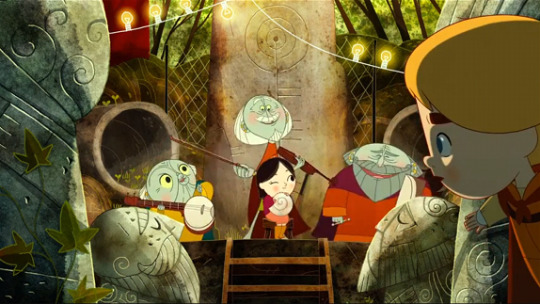
All throughout Song of the Sea we see iconography of modern Ireland. Conor drinks a pint of Guinness (unlabelled but unmistakable), the front of the pub he sits in is decorated in proto-typical Irish pub fashion. On the wall in Granny's house sits proudly a picture of Jesus with the Sacred Heart lamp as she warbles along to the classic Irish children's song, 'Báidín Fheilimí'. Ben and Saoirse take refuge in a shrine to a holy well with a rag tree outside that is bursting with religious iconography as well as a toy sheep - symbols that are as much a part of the national identity as those pre-historic and mythological ones. There are also references to the assimilation of pop culture outside of Ireland in a Lyle's Golden Syrup tin, the Rolling Stones poster on Conor's old bedroom door and Ben's 3-D glasses and cape, an emulation of a superhero costume. These images are, ultimately, harmless but have overtaken their native counterparts. Although we see statues of the Sídhe in the background, these are not shrines but detritus, and they lie forgotten, covered in plants and moss, in the company of bags of rubbish and old televisions. The diminishing of one era of Ireland's history to make way for a newer more powerful and modern identity is just one kind of loss that is portrayed in Song of the Sea, but each character experiences their own version throughout. The loss of Bronach that has affected Ben and Conor; the potential loss of Saoirse as she grows sicker; the loss of Mac Lir that drove Macha to such despair she literally bottled her emotions and those of others until they turned to stone. All of this comes to a climax at the end of the film when these tragedies are laid bare. As in Wolfwalkers the greater connotations of this theme are presented on a smaller scale: Ben and Conor's pain by the loss of Bronach.

Ben and Conor are representative of the human world and so suffer her absence more visibly than Saoirse who approaches her mother's world with curiosity and ease. In contrast, Ben, although he misses Bronach, rejects the sea (her home and symbolic identity) and his sister, a physical as well as spiritual reminder of what's been taken away from him. He turns his back on his past as much as he mourns its loss. We see it less obviously in Conor who wallows in his own memories and grief and tunes out Ben's references to his mother "It's as though I've been asleep all these years. I'm so sorry." Ben's grief is more expressive compared to the inwardly focused Conor and even towards the end of the film when Ben is trying to help Saoirse, Conor brushes over his insistence that only her selkie coat can save her. It's only when Saoirse is finally wearing the coat and wakes up from her sickness that he finally engages with Ben on the subject of Bronach, "She's a selkie, isn't she? Like Mam." "Yeah." (Which looks like a weak conversation written down but it's the happy smile on his face and the emotion in his voice that give the single word weight). "Please don't take her from us." During the film's final sequence, when Saoirse sings her song and wakens the sleeping Sídhe, Bronach returns but only to take Saoirse away. With tears in her eyes she begins to lead Saoirse along until Ben and Conor stop her, not forcefully but pleadingly, "she's all we have." All they have is Saoirse, all they have is a thread connecting them to Bronach's world and their memories of her.
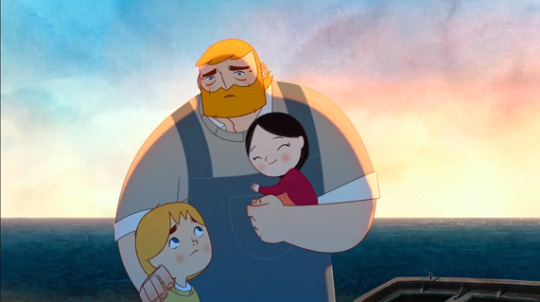
"All of my kind must leave tonight…" As the Sídhe are wakened by Saoirse's song we watch them rise joyfully to form a glowing processional in the sky as they make the journey across the sea to their home. This scene is so beautifully animated and so filled with a sense of magic and wonder that we are charmed into believing this is a good thing. The Sídhe are returned to their noble forms and going to their home "across the sea"; they fill the sky with a warm, mystical light, but they are taking that light and their magic with them. As Bronach quotes in the film's prologue, "Come away, o human child, to the waters and the wild, with a fairy, hand in hand, for the world's more full of weeping than you can understand." This is a world that can no longer bear the force of two identities. Unlike The Secret of Kells where Brendan and Aisling were allowed to live alongside each other without compromising their beliefs or ways of living, Bronach, a spiritual being, is forced to leave, while Ben and Conor have no choice but to stay and Saoirse, who walks both worlds, is made to choose between them. Although this is a happy ending it is still being depicted on a personal level. On a grander scale, the country has lost something that isn't coming back and this is depicted as a relief for the ones leaving it behind. On the other hand, Saoirse's decision to remain shows that, in small pockets of the country, the magic can remain.
It is fitting that Song of the Sea, as a representation of modern Ireland, draws on loss; Ireland has been experiencing loss on a grand scale for centuries. Although the march of progress is mostly positive, in some cases it has altered our respect and interest in the past. Today there is a nihilism attached to Irish heritage - the spirituality that's associated with airy fairy hippies dancing naked in a moonlit field; the language that is almost universally despised by every secondary student forced to grapple with the Tuiseal Ginideach; its disappearing and continually exploited ecological landscapes; the preservation of archaeological sites in frequent battle with the progress of industry. In the interest of leaving behind the worst of our past we are at risk of losing the best. The writer Manchán Mangan suggests that this desire to forget lies in the pain we feel when we consider our history. Some, like Conor, try to push all reference to this pain out of their lives, others, like Ben, divert their pain into misplaced anger. Mangan cites the Famine as a source of generational pain and its effect today on our use of the language, but really it can be attached to many events and periods of time, "English was the future; Irish would only bring suffering and death." This is a sentiment that carries through to this day; despite encouragement from schools, local councils and the government, Irish remains a least favourite subject for most people who dismiss it as unuseful for success in the wider world. By proxy, anything to do with the notion of "Irish", the language, history and culture, is old-fashioned (suffering and death) while success and the future lie outside of the country. Mangan goes on to suggest that only by confronting the pain of our past can we unlock an ability in ourselves to engage more fully with our identity, "We might stop blaming our failure to learn on teachers, or the education system, or Government policy, and realise that we have no difficulty learning any other subject…" Ben and Conor are given the opportunity to say goodbye to Bronach before she leaves, allowing them to carry on with their memories of her and the last strand of their connection to her as represented by Saoirse. More and more people today are looking to Ireland's past, ecology and language for whatever it is they need or want to find in life. It isn't necessary to convert to paganism and live on the shores of the Connemara coastline to achieve this connection, but actively disengaging from your past can only hurt more than it can help. In their respective stories Brendan does not compromise his beliefs but still builds a friendship with Aisling, while Robyn and Bill integrate fully into Médb and Moll's world. There is no right way to engage with this side of our history and identity, but in contrast to Ben and Conor, Brendan and Robyn have balanced and fulfilling relationships with their native counterparts. Ben and Conor were stuck in their pain over Bronach's loss and it is only after getting to see her one last time that helped them to move on and heal. Conor tells Bronach that he still loves her and he will carry that love and his memories of her througout his life as a source of joy rather than sadness; Ben lets Saoirse into his life and is able to move past his grief and fears of the sea. Here, the threat of loss and destruction comes from within and can only be treated by engaging with the past - its rich heritage and tragic history - and moving on with all of the wisdom and experience it provides. All three films in Cartoon Saloon's Irish mythology trilogy suggest that the integration of both worlds, an engagement on some level between the two, is not, perhaps, necessary to live, but is certainly recommended.

#another late post because my laptop charger broke#cartoon saloon#the secret of kells#song of the sea#wolfwalkers#irish mythology#irish movies#animated movies#animated films#animation#essays#film analysis#movie analysis#i do go on and on don't i
46 notes
·
View notes
Note
Every time you post I just wanna know more about EE and Rarity. This is your excuse to just talk about it, I wanna read whatever you say
Ahhh that means a lot! I’m glad you like them :D I’m just going to use this ask for general trivia alsjsksk thanks for the opportunity to ramble!
1. EE was heavily inspired by Ludwig II of Bavaria and his architectural projects! EE takes after a lot of the aesthetics and elements associated with him in both the puppet and the superstructure. He also shares his idealisation of past eras and focus on preserving beauty, to the point of neglecting functional/material concerns.

2. Originally my idea for the campaign was supposed to revolve more around Rarity’s purpose as a mobile memory conflux, so it was more about going to different areas and documenting the environment. Each area successfully documented was supposed to symbolise a corresponding tie with the world, so that Rarity would essentially carry the world within its cells. This would mean that it wouldn’t be able to ascend after entering the void but would simply continue to record until it returned to the material plane with its newfound knowledge. Anyway I scrapped this idea because I had no idea how it would work gameplay wise and also couldn’t come up with that many unique areas :’)
3. The pearl garden region was a result of EE trying to create Rarity. His first attempt of merging biological tissue with pearls was successful but uncontrolled, and the result was too unstable to be any useful in retaining information. The material has high reproductive capacity but an extremely short lifespan, so it infects any living being and basically turns them to pearl statues. Over time, the material spread from the test site and covered the island EE is situated on, wiping out the ecosystem and beginning to strangle the superstructure. EE appreciates the aesthetic value of the infection even though he is very dying.
4. The echo which gives Rarity max Karma, Ten Chimes over Deep Water, was a member of EE’s maintenance crew and also EE’s favourite musician. They were very attached to EE and admired his artistic capabilities, but didn’t share his philosophy that beautiful things should be preserved forever, alive or dead. Chimes was, like other Ancients, used to the world, and they found its lack of novelty tiring. They were therefore enthusiastic about ascension and curious about the world beyond. Nevertheless, they were the last to leave EE’s superstructure for mass ascension. EE viewed their departure as a betrayal and forbade them from ever returning, so Chimes’ echo lingers on the far shore.
5. Rarity is solar powered and well adapted to the barrenness of EE’s surroundings. It likes sleeping in the sun :3 The rain in the region is gentle but floods are common due to poor drainage, so hibernating is still occasionally necessary.
That’s about all I’ve got for now! Might add on more if anything comes to me aldjsksk thanks for the ask!! Also feel free to ask question from here if there’s anything you’d like to know :D
105 notes
·
View notes
Text
Mario and Luigi Brothership motif analysis
Having been going over the trailer for Mario and Luigi Brothership, one key detail I have picked up is that plugs and electrical sockets serve as a key design motif and likely tie into the larger overall plot.

Starting off we can see with Connie how her hat clearly resembles an electrical plug with her face being a socket. The bow like protrusions on top of her head are likely meant to resemble wires.


You can also clearly see this design motif carry other into the other NPCs as seen in this scene with Peach. The pink girls face is clearly based off the common 3-pronged Type B socket commonly seen in North America as well as Japan and Taiwan. The green fellow's face more closely resembles a Type H socket most commonly used in Israel. Its harder to say with the yellow and blue faced NPCs although the round eyes make me think of the Type C/D sockets used in Europe and India respectively.

Now taking a look at Snoutlet who apparently serves as the new Starlow. Besides the pretty obvious word play, you can also see how his/her tail clearly resembles an AC adapter plug.

With the Extension Corps who will probably serve as this game's villain trio, besides the obvious play on extension cord, you can see how their hands/weapons resemble electrical prongs and their clothing is heavily styled to resemble the body casings of electrical plugs.

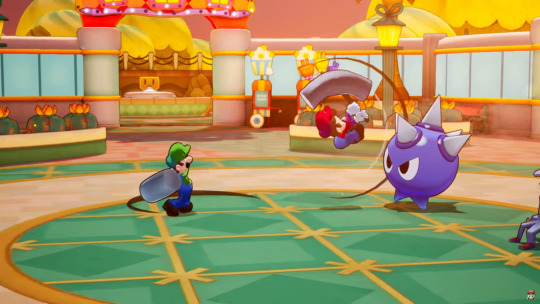
We can also see this motif of plugs and sockets extend to the environments and architecture.
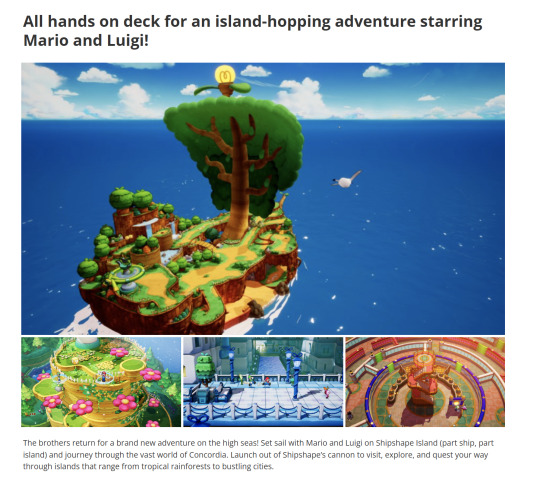
From Nintendo's official web site we can see that the name of the region Brothership takes place in is called Concordia an obvious play on cord and the Argentina city of Concordia
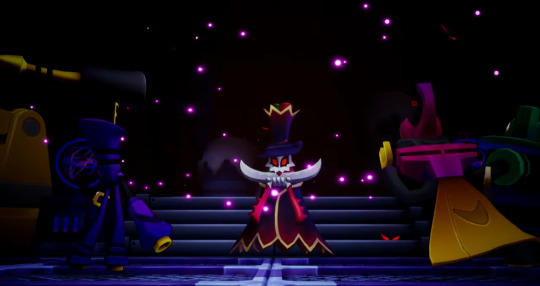
Finally taking a look at the new villain of the day while he doesn't have the plug and socket motif like the other new NPCs he still manages to tie into the electricity theme with how the top of his hat resembles a bundle of wires.
#mario#super mario#mario and luigi#mario and luigi brothership#nintendo#nintendo switch#analysis#design motifs
41 notes
·
View notes
Text

Fiji Tulou, China
Fujian Tulou are traditional rural dwellings native to the mountainous regions of Fujian Province in southeastern China. These large, circular or rectangular fortified buildings were built by the Hakka people and other communities from the 12th century onwards, primarily to serve as communal homes for multiple generations of a clan or extended family.
Tulou (meaning "earth structure") are designed for defensive purposes, with thick earthen walls made of rammed earth, wood, stone, and other materials, often several feet thick, making them impervious to attack.
The main characteristics of Fujian Tulou are:
1. Circular or rectangular shape
Most tulou are circular, but some are rectangular or square. These shapes create a courtyard in the middle, encouraging communal living.
2. Defensive design
Tulou were built to protect residents from bandits, with only small windows on the upper floors and a single fortified entrance.
3. Large capacity
Some tulou can accommodate hundreds of people and often include living quarters, storage areas and communal halls within the same structure.
4. Self-sustainability
Tulos often contain wells, farming plots and food storage, allowing residents to be self-sufficient during periods of long isolation.
In 2008, several sites of Fujian Tulou were listed as UNESCO World Heritage Sites for their unique architectural forms, cultural significance and historical importance.
They are an impressive example of how communities in ancient China adapted to their environment and fostered a strong sense of community and advocacy.
Image credit to respective owner.
Fujian Tulou are traditional rural dwellings native to the mountainous regions of Fujian Province in southeastern China. These large, circular or rectangular fortified buildings were built by the Hakka people and other communities from the 12th century onwards, primarily to serve as communal homes for multiple generations of a clan or extended family.
Tulou (meaning "earth structure") are designed for defensive purposes, with thick earthen walls made of rammed earth, wood, stone, and other materials, often several feet thick, making them impervious to attack.
The main characteristics of Fujian Tulou are:
1. Circular or rectangular shape
Most tulou are circular, but some are rectangular or square. These shapes create a courtyard in the middle, encouraging communal living.
2. Defensive design
Tulou were built to protect residents from bandits, with only small windows on the upper floors and a single fortified entrance.
3. Large capacity
Some tulou can accommodate hundreds of people and often include living quarters, storage areas and communal halls within the same structure.
4. Self-sustainability
Tulos often contain wells, farming plots and food storage, allowing residents to be self-sufficient during periods of long isolation.
In 2008, several sites of Fujian Tulou were listed as UNESCO World Heritage Sites for their unique architectural forms, cultural significance and historical importance.
They are an impressive example of how communities in ancient China adapted to their environment and fostered a strong sense of community and advocacy.
20 notes
·
View notes
Text


In view of the irreversible advent of electric vehicles filling stations face an uncertain future: for more than a century they have woven themselves into the urban fabric, underwent changes in terms of size, design and utility and occupy prominent, conveniently located sites. Accordingly their future has to be evaluated and their potential re-use, adaptation or transformation needs to be discussed. For or a critical discussion of filling stations and their future the creation of inventories and types is a prerequisite and serves as inevitable point of departure. The EAST - Laboratory of Elementary Architecture and
Studies of Types of EPFL Lausanne followed this approach in their survey of Lausanne filling stations, research that has recently been published by Triest Verlag in the present volume „Filling Stations - Studies on Types“.
But before the book gets to the local examples of filling stations the researchers around Anja and Martin Fröhlich dig deep into the history of filling stations and provide a summary of the historical development of this building type, beginning with the petrol pump and ending with contemporary combinations of canopied petrol pumps and separate convenience store. This development history is illustrated by a large number of examples that demonstrate the gradual stylistic decline of the filling station into a simple bearer of corporate identities. Interestingly, the EAST’s perspective on the filling station doesn’t focus on the building alone but also includes the global petroleumscape and thus offers a comprehensive overview of the multi-layered production of space in the name of petrol.
A very interesting concrete example for the repurposing of a filling station featured is Carmody Groarke’s „The Filling Station“ restaurant in London that reused the existing structure and reimagined the building’s relationship with the surroundings. In line with the latter the architects shielded the canopied space off from the street and opened it towards the adjacent canal in an act of scenic change.
The book ends with the examination of 22 filling stations in the Lausanne region that takes into account not only the station alone but also the urban context as well as adjacent buildings and programs, important information for the evaluation of the future potential of a particular structure. It is this potential that is of pivotal importance in the EAST’s research and opens creative perspectives on a building type that needn’t disappear but offers considerable adaptive potential.
#gas stations#filling station#archietctural research#architecture book#architectural history#book#triest verlag
17 notes
·
View notes
Text
My 25 Most Reread Books
thanks to @francesderwent for starting this, and @cakeyouareoh for typing up rules so i could just copy them
rules: everything on the list is fiction. the books listed are not necessarily my favorites, they’re the ones i’ve reread most often. some of them i haven’t read in decades, but i read them over and over as a kid. mine are not ranked, and are in random order. i chose one most-read book by each favorite author. i will add more clues if needed, and update the list as i go with the answers.
anne of green gables by l. m. montgomery - reading this feels like coming home. despite the pain, there is always hope and wonder if you look for it. (dr hq)
the murderbot diaries (yes the entire series) by martha wells - redacted (@drharleyquinn-medicinewoman and @cakeyouareoh)
pride and prejudice by jane austen - the most perfect couple isn't even the main one in this story. but the main one is perfect to me. (drharleyquinn-medicinewoman and @cakeyouareoh)
fruits basket by natsuki takaya -sentient calendar falls in love with a girl. the calendar is multiple people, and the book is a manga series. (cake)
jane eyre by charlotte brontë - proving goth was never just a phase. also he's terrible idk why i reread this book so much. (dr hq and cakeyouareoh)
uglies by scott westerfeld - maybe she's born with it. maybe it's mandatory. there was a movie made about it recently. (fran)
curses, inc. by vivian vande velde - fantasy short story compilation from my youth. it’s by an author i asked cate and cake about. (cake)
the locked tomb series by tamsyn muir- spooky scary skeletons (@sparrowposting)
the lunar chronicles by marissa meyer - what if the real fairy tales are the friends we made along the way ( @cakeyouareoh )
twilight by stephenie meyer - it makes no damn sense. compels me though. takes place in the pacific northwest, mostly. (cake)
if we were villains by m. l. rio - theatre kids scare the living shit outta me. (@sparrowposting)
elantris by brandon sanderson - i recognize it makes no sense, but i still think she should have chosen the priest instead of the god. (@justanawesomeowl)
she was an artist girl, he was a biker boy
"surely *i* can mess around with forces i don't know anything about, because i know everything" says the main character
humanity is always with us, but perhaps it's also learned. 3rd in a series that I highly recommend.
enders game by orson scott card - what if up is sideways? you need to rethink your assumptions. (@ontheedgeofgreatness and @snailthimbles)
redwell by brian jacques - local monk becomes hero and is kicked out of his order. he’s still an integral part of the community, though. (fran)
harry potter by hatsune miku - whoops, my millennial is showing. i very much dressed up for midnight book releases as a kid. also movies as a teen/young adult. (@scrunchie-face and cake)
the hobbit by jrrt - the heroes journey. and then unjourney. (fran)
the hunger games by suzanne collins - the film adaptation was very much life imitating art. (cake)
this is how you lose the time war by amal el-mohtar and max gladstone - star crossed lovers in spacetime (@sparrowposting)
what happens when you get your doctorate in architecture, but don't have to study humanities. alternatively: a clock hand cures asthma.
the mediator series by meg cabot - what if melinda gordon were a teenager? written by author whose other series was turned into a much beloved movie. (dr hq)
from the mixed-up files of mrs. basil e. frankweiler by e. l. konigsburg - siblings take the ultimate field trip. Also learn clerical work. ( @ontheedgeofgreatness )
contraband diary at a dig site. If you’re reading this, I already hate you.
11 notes
·
View notes
Text

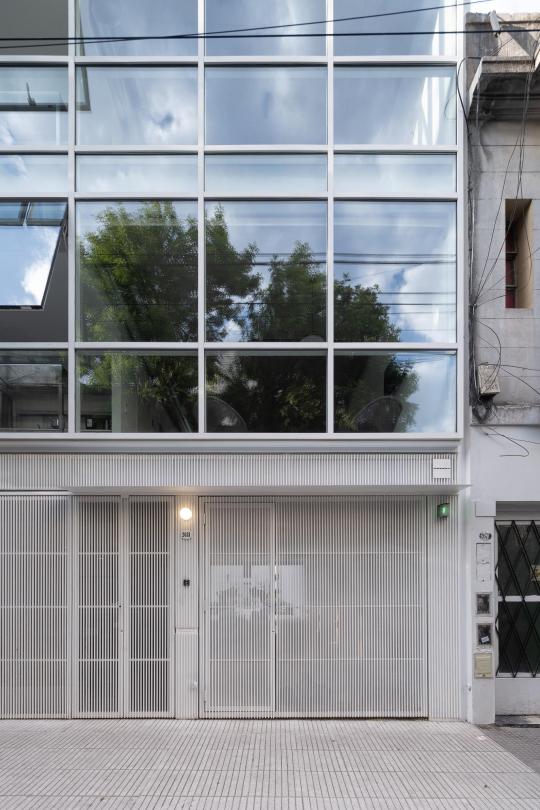
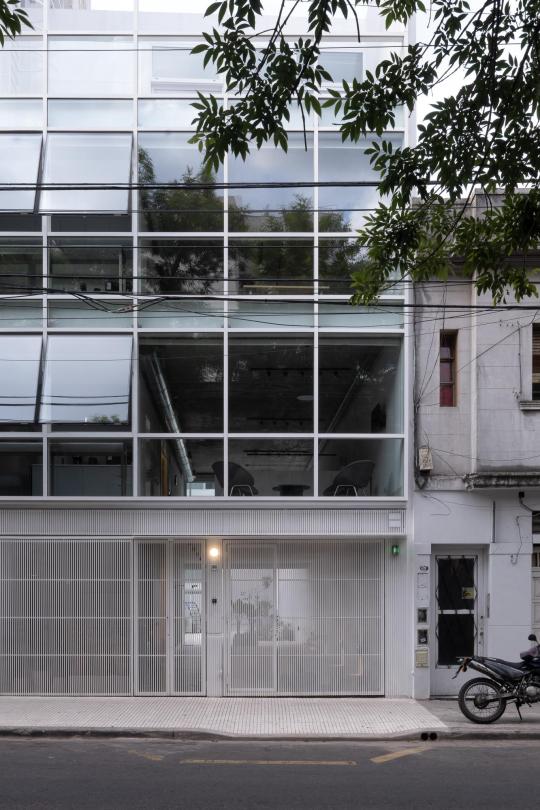
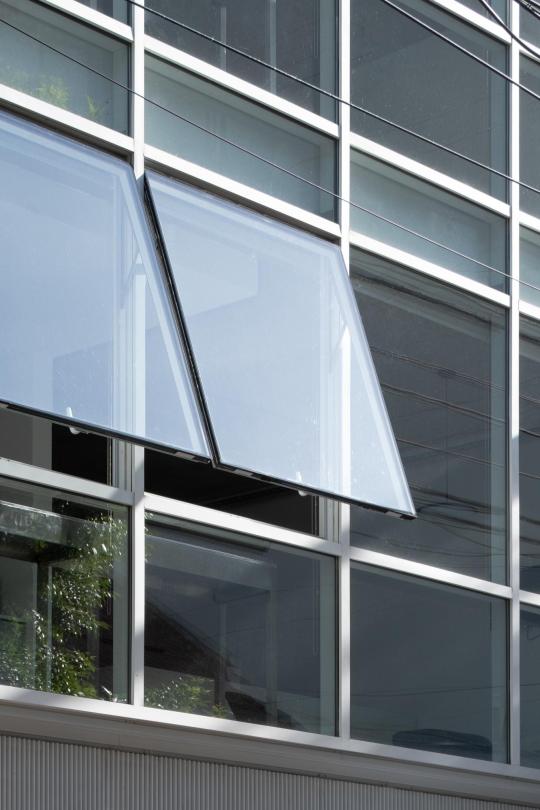
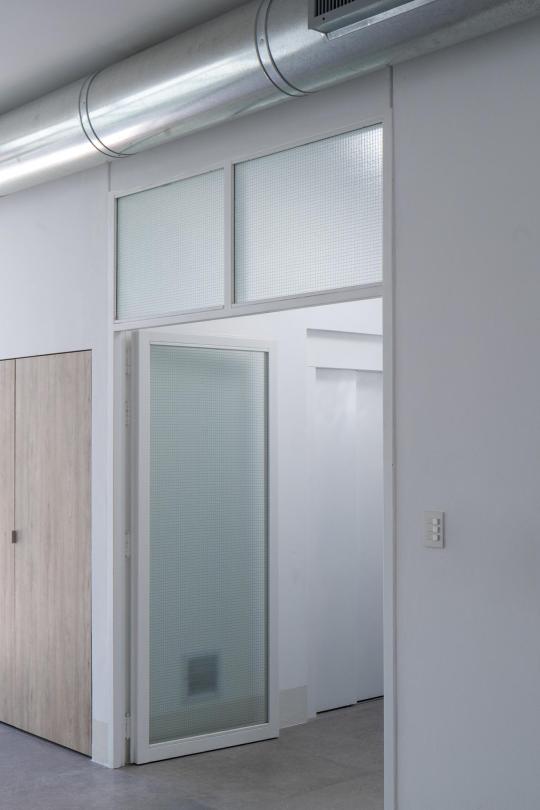
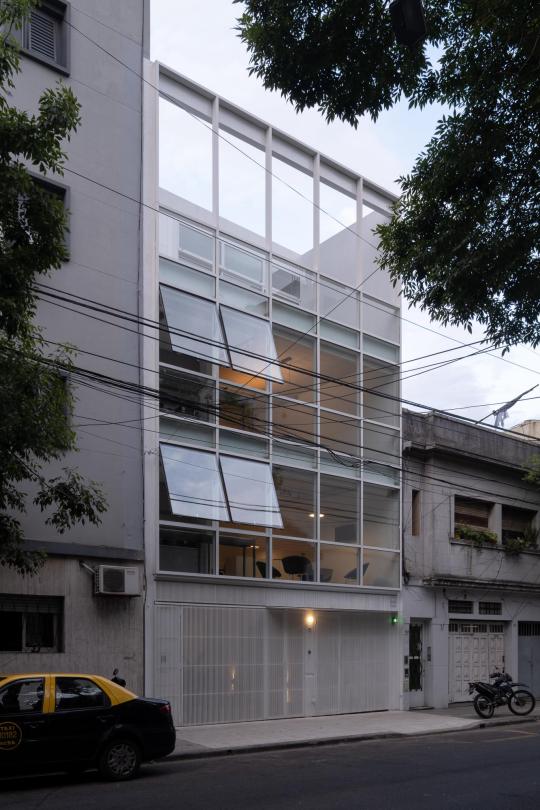
Moreno 2681 by palca estudio
The project is located in Balvanera, a central neighbourhood of Buenos Aires that presents a heterogeneous built profile with a strong commercial presence and an identity characterised by cultural diversity. This pattern is further consolidated when understanding its direct link with the building of the Argentine National Congress, with the large number of hotels distributed throughout the area or with the Miserere Square, that acts as a hub for trains, buses and subways. Balvanera could be interpreted as a neighbourhood of national identity.
Architecture as identity. The assignment originates from the clients' need to have administrative offices in new building that determines their identity as an institution. These offices had to be complemented by apartments to be used by people travelling from the provinces of Argentina to Buenos Aires for a certain period of time. Among the clients' initial demands was the use of a glass façade as an image towards the city, which for us was an essential part of the initial program.
The potential of mixed uses. The initial idea was to locate work and domesticity in the same block. This option was rapidly discarded after the first tests when the incompatibility of the circulation dynamics was verified. Taking advantage of the long proportion of the site (7.60 x 47.60 m) it was then decided to divide the uses into two independent blocks: the office one in the front, more exposed to the street and the domestic one in the back, more reserved in the centre of the block. In this way, a daily relationship is generated between all the people who inhabit the building while providing privacy in each of the parts.
Adapt to the given conditions. Both blocks adjust their buildable profile to the limits determined by the internal front line. This imaginary line is determined by the Government of the City of Buenos Aires to delimit a non-buildable area in the centre of the block. Instead of looking for alternatives to deal with this restriction, the project adapts to the resulting silhouette. In this way, two individual blocks are proposed to take advantage of all the possible footprint and are developed with the necessary height to deal with the proposal.
The void as a meeting place. Both building blocks are connected through a central void that works as a meeting point. This void is projected through a garden of organic shapes, white stones and growing vegetation that aims to generate meeting places for the people who work and inhabit the building.
Versatile and timeless from the beginning. The office block is planned on four levels with open spaces that allow to deal with the constant changes in today's work dynamics. Each level has outdoor spaces materialised by balconies on the lower floors and a terrace on the upper floor. The domestic block is also planned on four levels but made up of two stacked duplex apartments. Each one of them operates as an individual unit designed with the minimum elements necessary to be temporarily inhabited.
How to be efficient in the Argentine context. In an economic context as complex and variable as the Argentine one, it is necessary to be rational and efficient in the materialisation of architecture. In that sense, the construction of the building is proposed in a synthetic and traditional way through the implementation of few elements, but optimising their use. To do this, we proposed a reinforced concrete skeleton and lightweight masonry walls, textured white anodised aluminium frames in the windows and airtight double glazing for greater thermal efficiency. In this way, we make it easier to deal with suppliers while achieving efficiency and durability in the use of the elements.
A new way of perceiving the environment. Faced with a complex and heterogeneous urban context, the project is created from synthesis as contrast. Pure lines, geometric composition and white elements characterise a building that aims to communicate order and timelessness.
Design: palca estudio Location: Balvanera, Buenos Aires, Argentina Year: 2023 Photography: Javier Agustín Rojas
29 notes
·
View notes
Text




Lyne Lapointe’s works for Becoming Animal, her exhibition of new work at Jack Shainman Gallery, natural and hand made materials add dimension to works focused on the body and its connection to the natural world.
From the gallery-
Inspired by a passage in A Thousand Plateaus, written by French philosophers Gilles Deleuze and Félix Guattari, the exhibition title recalls the attitude they describe as being essential to the creative process: ‘becoming animal,’ or, an ability to inhabit different material and ontological perspectives. This phrase philosophically expresses a consistent quality in Lapointe’s work, namely her ability to ‘embody’ her materials—whether it be ink or glass beads, coral or abandoned beehives—by allowing them to retain their own specificity while also fully incorporating them into the pictorial spaces of her figures. Just as Lapointe’s materials contribute to the transformation of her figures, so too do they undergo their own metamorphosis as they are integrated into the compositions, a process that reflects the body’s capacity to adapt and change while still retaining continuity with the past.
Over the past four decades Lapointe has created poetic and materially complex works that consider the corporeal and psychological consequences of existing in a world of uncertainty. Her site-specific installations and architectural interventions created throughout the 1980s and 1990s, in partnership with critic and artist Martha Fleming, established many of these essential thematic concerns. At their core was the role that social spaces play in creating and modifying subjectivity, an experience Lapointe has continued to dissect and explore through other media, including the paintings on paper in this exhibition. Together, they demonstrate her consistent focus on the body and its relationship to external factors, whether they be socially constructed or naturally occurring.
Through research, careful sourcing and sustainable practices, Lapointe has expanded her process to include heterogeneous materials and found objects alike. In Beehives Apiarists (2024), the diptych’s beehives have been affixed to the figures while propolis—a resin-like substance produced by bees and typically used for medicinal purposes—has been used to cover the works entirely. In Mother of Pearl (2024), a large shell has been placed at the center of the figure while pearls punctuate the background. In Vitro (2024) brings together blown glass eggshells, hemp and recycled linens. Lapointe’s method of collecting these items, locating additional materials and preserving their respective histories is a process that metaphorically expresses her long-standing desire to use resources that not only describe our world, but that remind us of its innate worth and beauty and thus of our own as well.
By incorporating objects found in nature and the home, Lapointe creates moments that reimagine the body and place it in a point of transition. At times between genders, while at others void of identity altogether, her figures always question the viability of personal expression in our current socio-political context. Though typically characterized by vulnerability and fragility, they also and just as often embody a position of triumphant resistance to a world that seeks to restrict gender expression, categorize sexuality and stigmatize ‘otherness.’ When responding to a world of danger and hostility her figures can don protective armor, as in Black Billed Cuckoo / Magnolia Grandiflora (2023) and Okinawa (2024). In the series The Head and the Body (2024) Lapointe renders each figure in both deep black ink and shimmering gold leaf, suggesting an inner psychological world that the materials merely hint at. This is a world where resilience and radiance take form as proffered by the gold leaf, while tenacity, seen in the deep opacity and outward reaching gesture of the inked figure, takes root.
Though Lapointe’s practice has often centered femininity and womanhood in its many personal and social forms, in Becoming Animal she has gone one step further by creating figures that appear genderless, or which seem to exist outside of such rigid codification entirely. The found objects she uses to characterize these anonymous forms also signify their environmental context and invite viewers to consider the works through the lens of environmentalism. By encouraging each figure to occupy multiple ontological perspectives at once, Lapointe creates both a literal and conceptual connection to the construction of the works themselves. They straddle the line between painting, sculpture and collage, while finding ways to express the body in a fugue state through her singular craftsmanship and mastery of materials—or as Deleuze and Guattari write, they seek to ‘un-human the human.’
This exhibition closes 4/12/25.
#Lyne Lapointe#Jack Shainman Gallery#Art#Art Show#Chelsea Art Galleries#NYC Art Shows#Chelsea Art Shows#Collage#Felix Guattari#Gilles Deleuze#Jack Shainman#Mixed Media#Mixed Media Art#Painting#Sculpture#Becoming Animal
5 notes
·
View notes